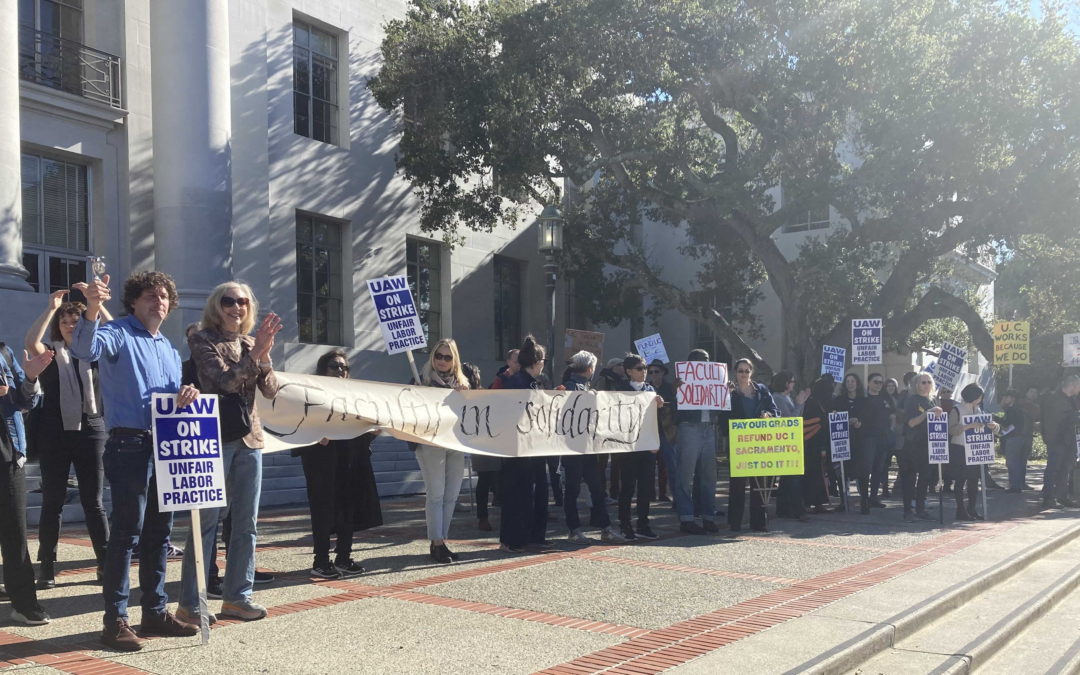For a week now 48,000 graduate students, postdocs, and student researchers across the University of California have been on the largest strike in the history of US higher education. It is part of a wave of protests that has swept through college campuses around the country in the last few years as auxiliary workers, graduate students, contingent instructional faculty, and tenure track professors have unionised and gone on strike. The strikes have highlighted the deteriorating pay and working conditions on US campuses. Once upon a time universities seemed privileged workplaces. Not any longer.
How did low pay, insecure contracts, and diminishing benefits become ubiquitous in the Ivory Tower? For decades public universities have been stripped of funds by state governments. At the University of California state disinvestment and rising tuition fees began when Governor Ronald Reagan disapproved of student protests and attempts to broaden the curriculum by groups previously excluded from the academy. In the past two decades as that defunding accelerated, the University of California also ceased to have a predominantly white student body.
State legislators and university administrators talk about the importance of diversifying the student and faculty body, but their policies have made that impossible. In order to compensate the lost public funding from the state, universities have steadily raised tuition and housing fees at the same alarming rates as private colleges. This has outsourced the funding of universities to private households and plunged an entire generation of students into debt.
Public universities have also tried to build up their endowments and commercial income in the forlorn hope that these could help make up for the lack of public funding. Despite hugely ambitious philanthropy campaigns, their inadequacy has been laid bare. Donors love new buildings and programs with their names on them, they do not fund improvements to existing buildings and classrooms, nor do they pay the wages and benefits of workers. That has forced universities to enroll more students in the quest for tuition revenue and, critically, to drive down labor costs.
That means when students attend the University of California, they are more likely to be taught by poorly-paid lecturers or graduate students than they are by a professor. Over the past decade there has been a 46% growth in the number of lecturers—who are paid a fraction of professors’ salaries and are only hired on temporary contracts. The median annual salary of a lecturer in 2019 was just $19,900 as opposed to $163,742 for professors. Graduate students also do a vast amount of teaching, indeed most of them literally teach to support themselves as they study and train on their programs. The average annual salary for graduate students is just $23,727.
These wages are all the more galling when we consider the escalating cost of housing and childcare across California. Those costs affect all those who work at the University of California. They make it increasingly difficult to recruit the best faculty and graduate students, or to retain lecturers, staff, librarians and auxiliary workers. Without doubt graduate students are at the front end of this structural crisis. They spend an average of 52% of their wages on rent and that means many of them, over 26% on all campuses end up food insecure and 5% or more are homeless. And that’s to say nothing of the absurd commutes many have to find affordable housing, the side gigs they take on to supplement their inadequate wages, or the toll all this takes on their mental health. This is not a sustainable way to train the next generation of researchers and teachers who will work in both the public and private sector.
These are the people who are being asked to teach the growing undergraduate population. Over the past decade the number of undergraduate students has grown 27%, and the university wants to enroll a further 30,000 students by 2030. While we know student-faculty ratios have grown considerably, we have no useful data on how much larger the classes our graduate students are teaching have becomes, and how many more student assignments and exams they are grading. But everyone who works or studies at a UC knows these ratios have grown dramatically. These working conditions are the learning conditions of students.
The system is broken, now is the time to fix it. Everyone, apart from the overpaid President and Chancellors who live rent free, is doing more and more for less and less. This strike across the UC system makes visible the structural crisis at the heart of the higher education in the state and the nation. It is time we all recognize the system cannot be made to work on debt-financed student tuition, or on cut-price wages and intolerable working conditions. If the median taxpayer in California were billed an additional $66 a year, for higher education, it would eliminate tuition, free up funds for housing, and deliver a high- quality and debt-free education at not just the University of California, but the Cal State and Community College systems.

